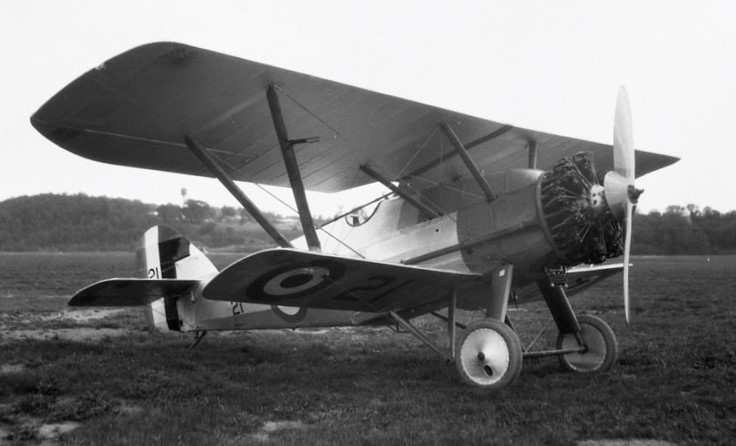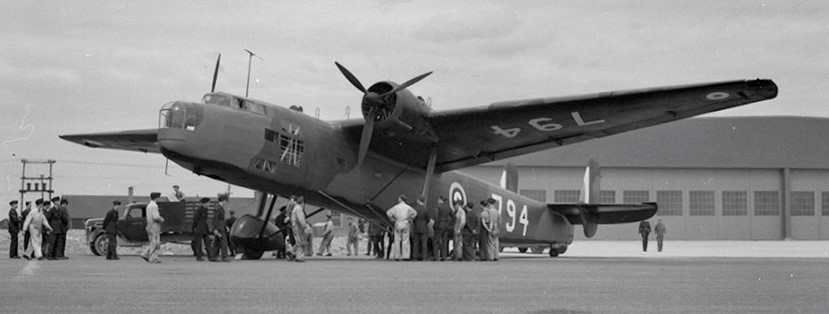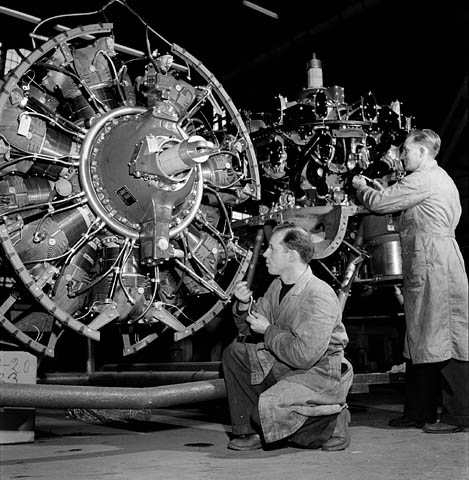Classic Canadian Aviation Photos
"Back in the day" classic photos of RCAF and commercial aircraft in Canada, from the Library and Archives Canada Photo records

(Library and Archives Canada Photo, MIKAN No. 4732064)
Canadian Aerodrome Baddeck No. 1 with Frederick W. "Casey" Baldwin and John McCurdy, preparing for military trials at Camp Petawawa, Ontario. Its first demonstration flight was made on 11 Aug 1909.

(Library and Archives Canada Photo, MIKAN No. 3388445)
"Ward" aeroplane trying out its engine, 5 Oct 1911.

(Library and Archives Canada Photo, MIKAN No. 5398687)
Lohner No. 1 aircraft being prepared for test flight, Rideau Canal, Ottawa, 14 March 1910. A group directed by the German mechanic George Lohner constructed this ungainly-looking glider, which flew at least once. As recorded in the Ottawa Citizen, 22 July 1910, it was towed aloft that day by a motorcar on the grounds of Landsdown Park. In this winter scene the crowd appears to be getting it ready to be towed aloft.

(DND Archives Photo, PL-115112)
Burgess-Dunne floatplane, Canada's first military aircraft, flown by the short-lived Canada Aviation Corps, c1914.

(Library and Archives Canada Photo, MIKAN No. 3390057)
Pilot Ascoti, Chief Engineer F.G. Ericson and Pilot Webster, ready to test the first Canadian JN-4 Canuck, Canadian Aeroplanes Ltd., Toronto, Ontario, 1917.

(Library and Archives Canada Photo, MIKAN No. 3390059)
Canadian JN-4 Canuck, Canadian Aeroplanes Ltd. Toronto, Ontario, 1917.

(RAF Photo)
Capt Billy Bishop VC, with Nieuport 17 C.1 Scout, No 60 Squadron, Royal Flying Corps, Filescamp, France, ca 1918. On 11 Aug 1917. King George V presented the Victoria Cross to Captain Billy Bishop. He was the first Canadian airman to receive the decoration.

(Library and Archives Canada Photo, MIKAN 3387943)
Armstrong-Whitworth F.K.8. On 27 Mar 1918, while flying an Armstrong-Whitworth F.K. 8, 2Lt Alan A. McLeod won the Victoria Cross for an action fought by him and his observer, Lt A.W. Hammond. 2Lt Alan A. McLeod VC grew up in Stonewall, Manitoba. During an air battle at an altitude of 5,000', 2Lt McLeod and his Observer, Lt A.W. Hammond MC, were attacked by eight German Fokker Dr.1 Triplane fighters. 2Lt McLeod skilfully manoeuvred to enable his observer to engage and shoot down three of the attackers. Wounded five times and with his aircraft on fire, 2Lt McLeod climbed out onto the left bottom-plane of his aircraft and proceeded to control his machine from the side of the fuselage. By steeply side-slipping the aircraft he was able to keep the flames to one side, thus enabling the observer to continue firing until the ground was reached. The observer had by now been wounded six times when the machine crashed in "no man's land," and 2Lt McLeod, not withstanding his own wounds, dragged him away from the burning wreckage at great personal risk from heavy machine-gun fire from enemy lines. Wounded again by a bomb while engaged in this rescue, he persevered until he had placed Lt Hammond in comparative safety before falling himself from exhaustion and lack of blood. He later died of influenza on 6 November 1919. He was Canada's youngest VC winner, and the youngest winner of a VC for an air action.

(Library and Archives Canada Photo, AH-517, PA-172313 and MIKAN No. 3238907)
Sopwith F.1 Camel, Capt William George Barker, VC, DSO & Bar, MC & Two bars, two Italian Silver Medals for Military Valour, and the French Croix de guerre. He was also mentioned in despatches (MiD) three times.
On 22 Oct 1918, William George "Billy" Barker was awarded the Victoria Cross for his actions on this day. While returning his Sopwith Snipe to an aircraft depot, he crossed enemy lines at 21,000 feet above the Forêt de Mormal, France. He attacked an enemy Rumpler two-seater which broke up, its crew escaping by parachute (the aircraft was of FAA 227, Observer Lt. Oskar Wattenburg killed). By his own admission, he was careless and was bounced by a formation of Fokker D.VIIs of Jagdgruppe 12, consisting of Jasta 24 and Jasta 44. In a descending battle against 15 or more enemy fighters. The dogfight took place immediately above the lines of the Canadian Corps. Severely wounded and bleeding profusely, Barker force-landed inside Allied lines, his life being saved by the men of an RAF Kite Balloon Section who transported him to a field dressing station. The fuselage of his Snipe aircraft was recovered from the battlefield and is preserved at the Canadian War Museum, Ottawa, Ontario. At a hospital in Rouen, France, Barker clung to life until mid-Jan 1919, and then was transported back to England. He was not fit enough to walk the necessary few paces for the VC investiture at Buckingham Palace until 1 Mar 1919. Barker is officially credited with one captured, two (and seven shared) balloons destroyed, 33 (and two shared) aircraft destroyed, and five aircraft "out of control", the highest "destroyed" ratio for any RAF, RFC or RNAS pilot during the conflict. The Overseas Military Forces of Canada recognized Barker as "holding the record for fighting decorations" awarded in the First World War.
In 1922 he rejoined the fledgling Canadian Air Force in the rank of Wing Commander, serving as the Station Commander of Camp Borden, Ontario from 1922 to 1924. Barker was appointed acting director of the RCAF in early 1924 and he graduated from RAF Staff College, Andover, England in 1926. While waiting to start RAF Staff College Course No. 4, Barker spent two weeks in Iraq with the RAF to learn more about the uses of airpower. He formally reported on his findings to the Minister of National Defence, and informally to Brigadier General Billy Mitchell, of the US Air Service. One of his achievements in the RCAF was the introduction of parachutes.

(Library and Archives Canada Photo, MIKAN No. 3390995)
Sopwith 5F.1 Dolphins, Canadian Air Force, No. 1 and No. 2 Fighting Squadrons, Upper Heyford, England, 1919.

(Library and Archives Canada Photo, MIKAN No. 3390924)
Royal Aircraft Factory S.E.5a, Canadian Air Force Capt W.B. Lawson, OC, No. 2 Fighting Squadron, CAF, Upper Heyford, UK, 1919.

(Library & Archives Canada Photo, MIKAN No. 3523020)
de Havilland DH.9a, No. 2 Squadron (No. 123 Squadron (Canadian), RAF), with four pilots, Upper Heyford, Oxfordshire, England, 1919.

(Library and Archives Canada Photo, MIKAN No. 3390431)
Fokker D.VII (Serial No. 8482/18), flown by Capt Albert Debrisay Carter, DSO & Bar, Belgian Croix de Guerre, from Moncton, New Brunswick. He is shown here shortly before he died on 22 May 1919, as he prepared to take off on the last flight to have a mock dogfight with an S.E.5a. No. 1 and 2 Fighting Squadrons, CAF, Upper Hayford, UK, 1919.

(Library and Archives Canada Photo, MIKAN No. 3388157)
Boeing C3 aircraft which inaugurated airmail service between Seattle, Washington, and Victoria, British Columbia, 1920.

(Library and Archives Canada Photo, MIKAN No. 3575578)
Felixstowe F.3 flying boat of the Canadian Air Board, 5 Sep 1921.

(Library and Archives Canada Photo, MIKAN No. 3643587)
Curtiss HS-2L, G-CYDT, Canadian Air Board, Victoria Beach, Manitoba, 3 Aug 1921.

(Library and Archives Canada Photo, MIKAN No. 3643591)
Handling party launching Curtiss HS-2L flying boat G-CYDS of the Canadian Air Board, 1 July 1921.

(Library and Archives Canada Photo, MIKAN No. 3582835)
Avro 504K, Reg. No. G-CYAX, Ottawa Air Station, Ontario, c1921.

(Library & Archives Canada Photo, MIKAN No. 3643537)
de Havilland DH.4, Reg. No. G-CYDM, Canadian Air Board, 4 Nov 1922.

(Library and Archives Canada Photo, MIKAN No. 3643581)
Canadian Vickers Viking Mk. IV, RCAF Reg. No. G-CYEV, Victoria Beach, 1923.
The Viking was a single-engine amphibious pusher biplane. Viking amphibians were built by Canadian Vickers Limited, a subsidiary company in Montreal, Quebec, with no previous aircraft manufacturing experience. Their involvement with the Viking led to a future line of indigenous flying boats beginning with the Canadian Vickers Vedette. Two Type 85 (Viking Mk. IV) delivered from Britain in 1923, followed by six aircraft built in Canada by Canadian Vickers at Montreal.

(Library and Archives Canada Photo, MIKAN No. 3387976)
Avro 504N Wright TS Patrol AWS floatplane, RCAF (Reg. No. G-CYGK), Shirley's Bay, Ontario, 30 September 1925.

(Library and Archives Canada Photo, MIKAN No. 3256151)
Avro Wright seaplane, RCAF (Reg. No. G-CYGK) at Ottawa Air Station, 1 Oct 1925.

(Library and Archives Canada Photo, MIKAN No. 3388238)
Canadian Vickers Vedette Mk. I flying boat, RCAF Reg. No. G-CYFS, Shirley's Bay, Ontario, 30 September, 1925.

(Library and Archives Canada Photo, MIKAN No. 3551347)
Curtiss Lark aircraft G-CAFB of Patricia Airways and Exploration Ltd, 1926.

(Library and Archives Canada Photo, MIKAN No. 3551367)
Mr. W. L. Brintnell [left] and associates with a de Havilland DH.60X Moth, Reg. No. G-CAIG of Western Canada Airways, Dec 1927.

(Library and Archives Canada Photo, MIKAN No. 3551352)
Mr. S. A. Cheesman in a Fokker Universal, Reg. No. G-CAFU 'City of Winnipeg' of Western Canada Airways, 1927.

(Library and Archives Canada Photo, MIKAN No. 3390541)
Mr. S. A. Cheesman in a Fokker Universal, Reg. No. G-CAFU 'City of Winnipeg' of Western Canada Airways, 1927.

(Library and Archives Canada Photo, MIKAN No. 3390511)
Fokker Universal, Reg. No. G-CAGD, Western Canada Airways, Manitoba, 1927.

(Library and Archives Canada Photo, MIKAN No. 3551351)
Mr. Bernt Balchen in a Fokker Universal, Reg. No. G-CAGD 'City of Toronto' of Western Canada Airways, 1927.

(Library and Archives Canada Photo, MIKAN No. 3359498)
Fokker Universal, Reg. No. G-CAHJ in background of a Walrus shot by personnel of the Hudson Strait Expedition, Nottingham Island, NWT, 3 Aug 1928.

(Library and Archives Canada Photo, MIKAN No. 3580234)
Bellanca CH-300 Pacemaker floatplane, Reg. No. CF-A, 19 August 1929.

(Library and Archives Canada Photo, MIKAN No. 3574057)
Photographer operating a K3 aerial camera in a Canadian Vickers Vedette Mk. II flying boat of the Royal Canadian Air Force.

(Library and Archives Canada Photo, MIKAN No. 3256679)
Canadian Vickers 'Vedette' V flying boat G-CYYZ of the RCAF, equipped with camera for oblique aerial photography, 24 August 1929.

(Library and Archives Canada Photo, MIKAN No. 3580579)
de Havilland DH.80A Puss Moth, CF-AGI, 23 Oct 1930.

(Library and Archives Canada Photo, MIKAN No. 3579902)
Avro 504N Lynx on skis, 23 February 1927.

(City of Vancouver Archives Photo, CVA 99-1802)
Canadian Vickers-built Avro 504NS, Jericho Beach, British Columbia, 8 May 1928. John Bowers and Marguerite De La Motte, Pantages stars. (City of Vancouver Archives Photo, AM1535-: CVA 99-1802)

Library and Archives Canada Photo, MIKAN No. 3580128)
de Havilland DH.60X Moth, Reg. No. C-GYYP, c/n 491, with Mrs. C.H. Walker preparing for a flight, 18 Aug 1928. The Certificate of Registration was issued on the 29th of May, 1928. The aircraft was struck off on the 16th of January, 1929.

(City of Vancouver Archives Photo, AM1535-: CVA 99-2155)
Fairey IIIF Mk. IV G.P. floatplane (1), RCAF (Serial No. J9172), Jericho Beach, BC ca 1930. This is the sole British-built Fairley III F to serve in Canada. It was used for trials October 1929 to September 1930.

(Library and Archives Canada Photo, MIKAN No. 3383400)
Fokker F.XIV, Reg. No. CF-AII of Western Canada Airways Ltd. inaugurating Prairie Air Mail service, Saskatoon, Saskatchewan, 3 March 1930.

(Library and Archives Canada Photo, MIKAN No. 3383411)
Fokker F.XIV, Reg. No. CF-AII of Western Canada Airways Ltd. inaugurating Prairie Air Mail service, Saskatoon, Saskatchewan, 3 March 1930.

(Library and Archives Canada Photo, MIKAN No. 3383422)
Boeing 40B-4 aircraft of Western Airways Ltd. flying the Prairie Air Mail service, 1930-1932.

(RCAF Photo)
Ford Model 6-AT-AS Trimotor, RCAF, Reg. No. G-CYWZ, St. Hubert, Quebec, June 1931.

(Library and Archives Canada Photo, MIKAN No. 3390564)
Ford Model 6-AT-AS Trimotor, RCAF, Reg. No. G-CYWZ, mounted on skis, Rockcliffe, Ontario, 17 Jan 1931.
Originally purchased for crop dusting experiments. First tests spraying hemlock forests near Westree, Ontario in June of 1929. Similar tests in Quebec later that year. Later based at Rockcliffe, Ontario, and used as VIP transport, and support transport for 1931 Air Pagent. Carried VIPs from Ottawa to St. Hubert to view and ride on R100 during its visit to Canada in 1931. Appeared at air show at RCAF Station Trenton in June 1934. Trials with Lear radio compass, September 1935. Sold to United Air Transport as CF-BEP. (Bill Walker)
.jpg)
(Library and Archives Canada Photo, MIKAN No. 3390748)
Junkers W-34 aircraft CF-ABK of Canadian Airways Ltd., 1936-1940.

(Library and Archives Canada Photo, MIKAN No. 3229756)
9 Dec 1929. Fairchild 71T, Reg. No. CF-AAT, first air mail flight Montreal-Quebec-Moncton-St.John. Arrival at Moncton from Quebec. CF-AAT was registered in March 1929 to Canadian Transcontinental Airways. It was merged into Canadian Airways Ltd in 1930. CF-AAT was damaged beyond repair in an accident 5 miles NW of Sioux Lookout, Ontario on 12 March, 1936.

(Library and Archives Canada Photo, MIKANNo. 3392748)
Fleet Model 2 aircraft CF-ANO, Doré Lake,P.Q. Taken 1932-1937.

(Library and Archives Canada Photo, MIKAN No. 3392747)
Fleet Model 2 aircraft, Reg. No. CF-ANO, Doré Lake, P.Q. Taken 1932-1937.

(Library and Archives Canada Photo, MIKAN No. 3192420)
Canadian Airways floatplane at the airport, 1933.

(Library and Archives Canada Photo, MIKAN No. 3642441)
Armstrong Whitworth Siskin Mk. IIIA, RCAF (Serial No. 21), ca 1934.

(Library and Archives Canada Photo, MIKAN No. 3574039)
Armstrong Whitworth Siskin Mk. IIIA, RCAF (Serial No. 21), later (Serial No. 302), RCAF Station Rockcliffe, Ontario, c1934.

(Library and Archives Canada Photo, MIKAN No. 3388460)
Primary glider built by McGill University Flying Club, Montreal, P.Q., November, 1933.

(Library and Archives Canada Photo, MIKAN No. 4295607)
Two bush pilots refueling their Northern Airways Fairchild FC-2W2 (later converted to a model 71C in 1949), Reg. No. CF-BXF.
.jpg)
(Library and Archives Canada Photo, MIKAN No. 3232304)
Westland Wapiti Mk. IIA, RCAF (Serial No. 513), RCAF Station Trenton, Ontario c1938.

(Library and Archives Canada Photo, MIKAN No. 3390772)
Lockheed 14-H2, Reg. No. CF-TCK, Trans-Canada Air Lines, Winnipeg, Manitoba, c1939.

(Library and Archives Canada Photo, MIKAN No. 3383396)
Officials with Lockheed 14-H2 aircraft of Trans-Canada Air Lines which made first night airmail flight, Regina, Saskatchewan, 2 March 1939.
.jpg)
(Library and Archives Canada Photo, MIKAN No. 3545907)
Grumman Goose Mk. II, RCAF (Serial No. 917), 1939.
.jpg)
(Library and Archives Canada Photo, 3199160)
Canadian Vickers Stranraer, RCAF (Serial No. 948), No. 6 (BR) Squadron, at its base at Alliford Bay, British Columbia. 948 was flown by No. 6 (Bomber Reconnaissane) Squadron, from RCAF Station Alliford Bay from 1941 to 1943. It suffered Category C damage at Patricia Bay, British Columbia on 28 April 1942. Struck off strength on 29 Nov 1944, on 5 Jan 1945 it went to the civil register as CF-BYB, registered to W.C. Stiple of Montreal. It was later exported to Aero Transport Corporation of Tampa, Florida, Reg. No. NR45326.
04 Mar 1936. No. 6 (Torpedo Bomber) Squadron was authorized at Trenton, Ontario. It was mobilized on 10 Sep 1939. On 31 Oct 1939 it was redesignated No. 6 (Bomber Reconnaissance) Squadron at Jericho Beach, British Columbia. The squadron was disbanded at Coal Harbour, British Columbia on 7 Aug 1945. The squadron flew the Canadian Vickers Vedette, Blackburn Shark Mk. II and II, Supermarine Stranraer, Consolidated Canso A, Consolidated Catalina Mk. IB and Mk. IIIA and Noorduyn Norseman

(Library and Archives Canada Photo, MIKAN No. 3642468)
Avro 621 Tutor, (Serial No. 188), flown by No. 110 (AC) Squadron, Ottawa, Ontario, 19 Sep 1939.

(Library and Archives Canada Photo, MIKAN No. 3383403)
Unloading of airmail from Lockheed 14-H2 Super Electra, Reg, No, CF-TCK of Trans-Canada Air Lines, Winnipeg, Manitoba, April 1940.

(Library and Archives Canada Photo, MIKAN No. 3199197)
Hawker Hurricanes on the tarmac, No. 135 Squadron, Boundary Bay, British Columbia, 1 July 1943. The Hurricane Mk. XII in the forefront appears to be 5407 which was taken on strength with the RCAF on 20 July, 1942. It went to No. 135 (F) Squadron at RCAF Station Mossbank, Saskatchewan, from the Canadian Car & Foundry (CCF) factory at Fort William, Ontario.. All the aircraft look like they just came off the assembly line. Check out the white inscription on the cowling of the third Hurricane in from the right. (Chris Charland)

(Library and Archives Canada Photo, MIKAN No. 3203451)
Handley Page HP 54 Harrow Mk. I , RCAF (Serial No. 794), on the ramp at Gander, Newfoundland, 19 August 1941.
This Harrow Mk. I originally carried the United Kingdom civilian aircraft registration G-AFRG. It was first used by the RCAF's Test & Development Flight and later served with Eastern Air Command, Halifax's Communications Flight and with Station Flight at Dartmouth.

(Library and Archives Canada Photo, PB-1406, MIKAN No. 3225024)
Bristol Beaufort Mk. I (Serial No. N1030), coded N, No. 149 (Torpedo Bomber) Squadron, RCAF, on patrol over Patricia bay, British Columbia, 18 June 1943.
.jpg)
(Library and Archives Canada Photo, MIKAN No. 5131009)
Vickers Wellington Mk. II (Serial No. W5515), RCAF No. 405 Squadron. W5515 was initially coded LQ*M. It later became also LQ*R and finally LQ*Y, and nicknamed "Moonshine" and later, "Berlin or Bust". The flight flight crew is in northern England. Left to right: F/Sgt. C.W. Higgins, pilot, F/Sgt. H. Wigley, pilot, Sgt. Lawrence J. Nadeau, wireless-operator air-gunner, Sgt. F.H.J. Farrell, navigator, Sgt. A. Smith, air gunner and Sgt. I Watters, second wireless-operator air-gunner. Each member of the crew wears a tiny figure as that depicted on their plane as a mascot.

(Library and Archives Canada Photo, MIKAN No. 4359665)
Vickers Wellington Mk. IA with RCAF flight crew, Sergeant McGillvray, Sergeant J. Holsch, Sergeant Spackman and Sergeant R.H. Gervin, plus one, c 1943.

(DND Photo via Gary Cook)
Canadian Vickers Canso A, RCAF, possibly (Serial No. 11010), No. 3 Operational Training Unit at RCAF Station Patricia Bay, BC. 11010 was taken on strength on 6 Nov 1943. It was delivered directly to No. 3 Operational Training Unit at RCAF Station Patricia Bay, British Columbia. To No. 2 Air Command for storage on 26 Jul 1945. Stored post war at No. 10 Repair Depot, Moose Jaw, Saskatchewan. It was struck off, to War Assets Corporation for sale on 7 May 1947. R.W.R. Walker.

(Library and Archives Canada Photo, MIKAN No. 3586797)
Boeing Canada Canso A, RCAF (Serial No. 9751), 24 Apr 1943.

(Library and Archives Canada Photo, MIKAN No. 4564727)
RCAF Flying Officer John West (left) and F/O Dave Bruce stand before their No. 159 Squadron, RAF, Consolidated B-24 Liberator Mk. VI (Serial No. BZ980), 'Goofy' just before taking off from Digri, India to attack Maymyo, an important Burma rail yard and supply route for Japanese troops, 12 May 1944.
The loss of one aircraft usually entailed multiple casualties. Four missing Liberators in No. 99 Squadron took the lives of 10 Canadians - seven of them in a single aircraft - between 3 Dec 1944, and 5 June 1945. From 23 July 1942, to 22 March 1945, 24 Canadians serving in No. 159 Squadron were killed in 11 Liberators; these included six lost in a single aircraft on 9 Feb 1945, and seven on 15 March 1945, again in a single Liberator. In No. 356 Squadron 21 members of the RCAF were killed between 28 Oct 1944, and 18 Aug 1945, in six Liberators.
Historian Terry Copp has declared that Canadian military history is not so much “unwritten” as “unread.” For those who would pursue more fully the history of RCAF Liberator aircrew in the Far East, there are several works, from privately printed memoirs, including Peace Persuader, published anonymously about 1995 to an extensive two-volume narrative titled Burma Liberators: RCAF in SEAC by John R.W. Gwynne-Timothy.

(Library and Archives Canada Photo, MIKAN No. 3197979)
Workmen assembling the nose of a Curtiss SB2C1 "Helldiver" aircraft on the production floor of the Canadian Car & Foundry Company Ltd., c1944.

(Library and Archives Canada Photo, MIKAN No. 5129634, and PL29380)
Handley Page Halifax B. Mk. III (Serial No. MZ808), coded BM-P, "Pride of the Porcupines". Aircrew and groundcrew members of No. 433 (Porcupine) Squadron, RCAF, No. 6 Bomber Group, gang up on the miniature English automobile owned by one of the aircrew members. Left to Right: LAC D.W. Higgins, LAC Tom Collins, AC "Duke" Ducarme, Sgt. Sandy Grant, air gunner; Sgt. Bill Keen, bomb aimer; F/Sgt. Bob Thomas, navigator; LAC Gordon Austin, Sgt. Bill Mackay, flight engineer; Warrant Officer Jack McNaughton, pilot. MZ808 crashed on Fynn Island, Denmark after being shot down by a 1./ NJG 3 night-fighter flown by Oberleutnant Herbert Koch while returning from a Gardening mission in Kiel Bay on 17 August, 1944.

(Library and Archives Canada Photo, MIKAN No. 3226555)
Handley Page Halifax A. Mk. VII's from No. 644 Squadron based at RAF Station Tarrant Rushton, Dorset, preparing to tow General Aircraft Hamilcar gliders of the 6th Airborne Division to Germany, 22 March 1945.
.jpg)
(Library and Archives Canada Photo, MIKAN No. 3199397)
Supermarine Spitfire LF Mk. IX, No. 414 Squadron, RCAF, 1 Feb 1945.

(RCAF Photo)
Canadian Car & Foundry Harvard Mk. 4s from No. 1 Flying Instructor School based at RCAF Station Trenton, Ontario.

(Library and Archives Canada Photo, MIKAN No. 3584128)
Sikorsky H-5 Dragonfly, RCAF (Serial No. 9603), 12 Feb 1948.

(Library and Archives Canada Photo, MIKAN No. 3390887)
Republic Seabee aircraft CF-EJI, c1950s.

(Library and Archives Canada Photo, MIKAN No. 3388273)
Consolidated PBY Canso, Reg. No. CF-EZX of Central British Columbia Airways at Vancouver Airport, BC, c 1950s.

(Library and Archives Canada Photo, MIKAN No. 3390573)
Russ Baker (standing) and Jack Crosby with a Grumman 'Mallard' aircraft of Pacific Western Airlines at Vancouver, Airport, 1952.

(Library and Archives Canada Photo, MIKAN No. 4448523)
Noorduyn Norseman Mk. IVM, RCAF (Serial No. 2476), coded GC-C, from the Central Flying School at RCAF Station Trenton, Ontario, anchored on Wabamun Lake, Alberta, 10 Aug 1952.

(Library and Archives Canada Photo, MIKAN No. 4950181)
RCAF High Altitude Indoctrination (HAI) training, 1951.

(RCAF Photo)
de Havilland DH.100 Vampire Mk. III (Serial No. 17021), Central Flying School, RCAF Station Trenton, Ontario.

(Library and Archives Canada Photo, MIKAN No. 4948820)
Canadair CL-13 Mk. 6 formation, RCAF Sky Lancers, 1955.

(RCAF Photo)
Canadair CL-13 Sabre Mk. 2 (Serial No. 19187), No. 439 Squadron, ca 1952.

(DND Photo)
Canadair CL-13 Sabre Mk. 5 (Serial No. 23360).

(Library and Archives Canada Photo, MIKAN No. 3604110)
Senior flight nurse Irene Sutherland poses beside a Saskatchewan Air Ambulance Cessna 195, c1957.

(Library and Archives Canada Photo, MIKAN No. 4952328)
Instructor and students, Bell 47 helicopter training, Okanagan Helicopters Ltd., British Columbia, 1960.





